| |

| Author |
Topic Options
|

 Posts:
Posts: 51900
 Posted: Posted: Wed Aug 02, 2017 11:01 am
In pictures: Astronomy Photographer of the Year 2017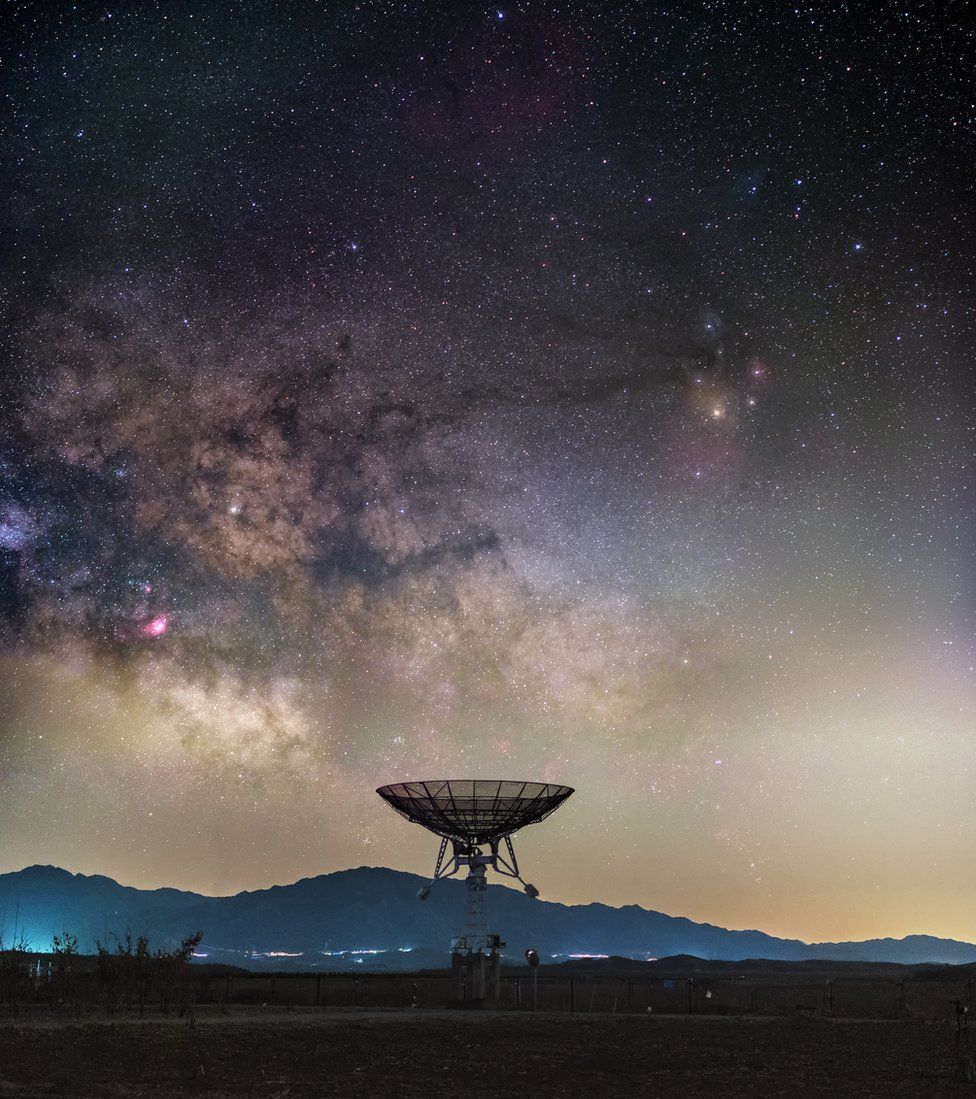 $1: The Milky Way rises above a small radio telescope at Miyun Station, National Astronomical Observatory of China, Beijing, in Haitong Yu's photograph.
"The image depicts light pollution, which together with electromagnetic noise, has turned many optical and radio observatories near cities both blind and deaf," says the photographer.
To make this image, Haitong Yu used a light-pollution filter and stacked multiple frames to show the Milky Way above the city light.  $1: Lying in the constellation of Gemini, IC443 is a galactic supernova remnant, a star that could have exploded as many as 30,000 years ago,
Its globular appearance has earned the celestial structure the moniker of the Jellyfish Nebula.
In this picture made by Chris Heapy, at the upper left of the Jellyfish Nebula there is a much fainter background area of nebulosity, which is a large cloud of mostly molecular hydrogen gas and dust.
Professional observatory data shows that what we are actually seeing are two lobes superimposed on each other, but from this angle one appears as the head of the jellyfish (to the left) and the other lobe (to the right) as the dangling tentacles.
|

 Posts:
Posts: 51900
 Posted: Posted: Tue Aug 08, 2017 7:16 am
$1: China built the world’s largest telescope, but has no one to run itDuring the second season of The Big Bang Theory, the aspiring actress Penny borrows money from Sheldon. Without a second thought, the theoretical physicist grabs a peanut brittle can in which he stores his extra money, and urges Penny to borrow as much as she wants. "This is money I'm not using," Sheldon explains. Nick Suntzeff, an astronomer at Texas A&M University, recalled this episode when asked why no astronomers had yet taken a lucrative position to run the world's largest radio telescope, in China. The job pays about $1.2 million annually. "Now, that is an exaggeration," Suntzeff said of the TV show. "But I know many astronomers who would do such a thing. They want to be paid well, yes, but the money does not buy you telescope time, or access to supercomputers, or fund postdocs and graduate students." China has built a staggeringly large instrument in the remote southern, mountainous region of the country called the Five hundred-meter Aperture Spherical Telescope, or FAST. The telescope measures nearly twice as large as the closest comparable facility in the world, the US-operated Arecibo radio telescope in Puerto Rico. Radio telescopes use a large, parabolic dish to collect radio waves from distant sources, such as pulsars and black holes—or even alien civilizations. According to the South China Morning Post, the country is looking for a foreigner to run the observatory because no Chinese astronomer has the experience of running a facility of such size and complexity. The Chinese Academy of Sciences began advertising the position in western journals and job postings in May, but so far there have been no qualified applicants. 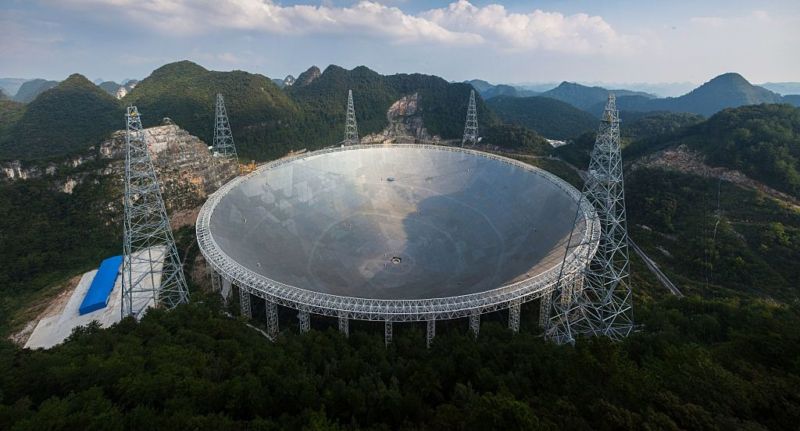 https://arstechnica.com/science/2017/08 ... to-run-it/
|
 Posted: Posted: Tue Aug 08, 2017 9:10 am
On Monday, August 21st, 2017, the continental USofA will be graced with a solar eclipse. This will be a once-in-a-life-time opportunity for space-nuts everywhere on the face of the earth.
The shadow will appear FIRST on the West coast and then disappear on the East coast. Do the math. Do the geometry.
|

 Posts:
Posts: 35255
 Posted: Posted: Tue Aug 08, 2017 2:26 pm
DrCaleb DrCaleb: $1: China built the world’s largest telescope, but has no one to run it
Radio telescopes use a large, parabolic dish to collect radio waves from distant sources, such as pulsars and black holes—or even alien civilizations. How many alien civilizations have they found so far, and why haven't I heard anything about this before today? ![huh? [huh]](./images/smilies/icon_scratch.gif)
|

 Posts:
Posts: 51900
 Posted: Posted: Wed Aug 09, 2017 6:01 am
raydan raydan: DrCaleb DrCaleb: $1: China built the world’s largest telescope, but has no one to run it
Radio telescopes use a large, parabolic dish to collect radio waves from distant sources, such as pulsars and black holes—or even alien civilizations. How many alien civilizations have they found so far, and why haven't I heard anything about this before today? ![huh? [huh]](./images/smilies/icon_scratch.gif) We put them on 'hold' while we find someone to talk to them.
|

 Posts:
Posts: 51900
 Posted: Posted: Wed Aug 09, 2017 6:41 am
$1: As eclipse madness spreads, so do conspiracy theoriesThe first solar eclipse to span the entire United States has lots of people justifiably excited. The midday disappearance of the Sun is a truly novel and moving experience. For many people, it's spiritual. Here's how the exceptional American author and essayist Annie Dillard described seeing an eclipse in 1979 in the Northwestern United States. $1: At once this disk of sky slid over the Sun like a lid. The sky snapped over the Sun like a lens cover. The hatch in the brain slammed. Abruptly it was dark night, on the land and in the sky. In the night sky was a tiny ring of light. The hole where the sun belongs is very small. A thin ring of light marked its place. There was no sound. The eyes dried, the arteries drained, the lungs hushed. There was no world. Ancient people didn't quite know what to make of eclipses, as they didn't fully understand the geometry of the Solar System, nor that Earth and its Moon orbited around the Sun in tandem and that sometimes the Moon passed between the Earth and Sun. Often, they believed, mythical creatures ate or captured the Sun. So perhaps it should comes as no surprise that, in the modern era, humans would their own myths about the eclipse. And because the forthcoming eclipse will cross the most prosperous country in the world, hucksters selling these myths are coming out now to peddle their ideas. Amazingly—well, perhaps not so amazingly considering our willingness to ignore reality—some people actually believe them.  $1: Do not stare at eclipse with remaining eye. - DrC https://arstechnica.com/science/2017/08 ... -theories/
|

 Posts:
Posts: 51900
 Posted: Posted: Thu Aug 10, 2017 8:19 am
$1: NASA’s plasma rocket making progress toward a 100-hour firinglmost everyone recognizes that if humans are truly to go deeper into the Solar System, we need faster and more efficient propulsion systems than conventional chemical rockets. Rocket engines powered by chemical propellants are great for breaking the chains of Earth's gravity, but they consume way too much fuel when used in space and don't offer optimal control of a spacecraft's thrust. NASA recognizes this, too. So in 2015, the space agency awarded three different contracts for development of advanced propulsion systems. Of these, perhaps the most intriguing is a plasma-based rocket—which runs on Argon fuel, generates a plasma, excites it, and then pushes it out a nozzle at high speed. This solution has the potential to shorten the travel time between Earth and Mars to weeks, rather than months. But to realize that potential, Houston-based Ad Astra Rocket Company must first demonstrate that its plasma rocket, VASIMR, can fire continuously for a long period of time. The three year, $9 million contract from NASA required the company to fire its plasma rocket for 100 hours, at a power level of 100 kilowatts, by 2018. This week, Ad Astra reported that it remains on target toward that goal. The company completed a successful performance review with NASA after its second year of the contract, and it has now fired the engine for a total of 10 hours while making significant modifications to its large vacuum chamber to handle the thermal load produced by the rocket engine.  https://arstechnica.com/science/2017/08 ... ur-firing/
|

 Posts:
Posts: 51900
 Posted: Posted: Thu Aug 10, 2017 9:43 am
CharlesAnthony CharlesAnthony: On Monday, August 21st, 2017, the continental USofA will be graced with a solar eclipse. This will be a once-in-a-life-time opportunity for space-nuts everywhere on the face of the earth.
The shadow will appear FIRST on the West coast and then disappear on the East coast. Do the math. Do the geometry. Ok! Let's do the math. The Moon's orbital speed, to the east is about 3,400 km/h. The Earth rotates to the east at 1,670 km/h. 3,400 – 1,670 = 1,730 km/h near the equator, from west to east. Over Mach 1.5! Lets do the geometry! So the Moon's orbit is not along the equator. 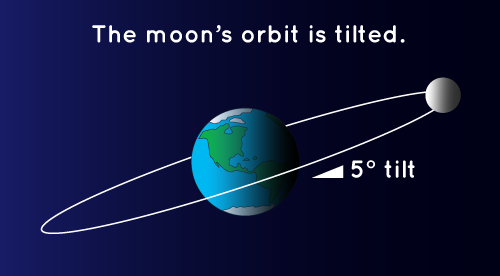 And the orbit progresses depending on the time of year: 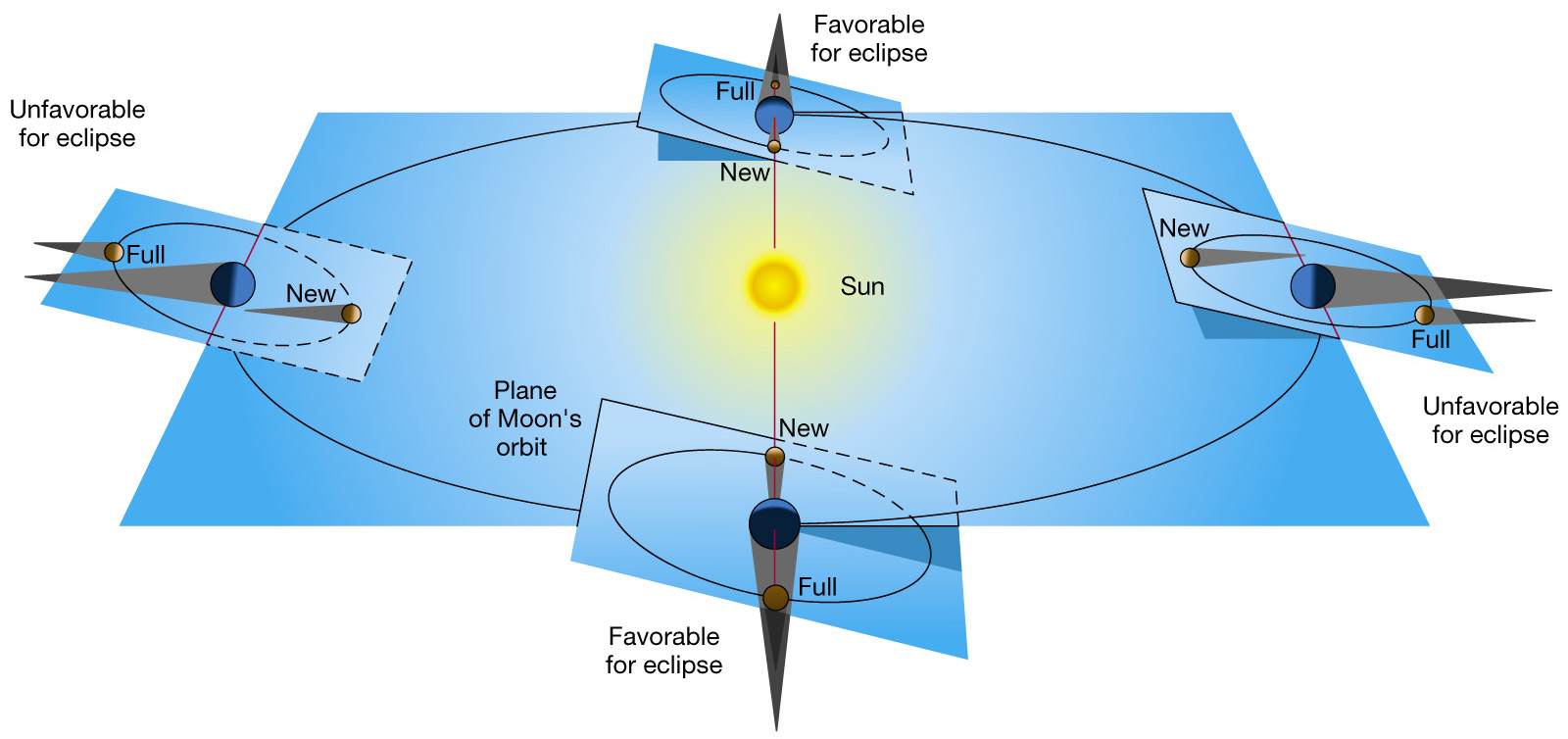 This page is really good at explaining the process: https://svs.gsfc.nasa.gov/4158
|

 Posts:
Posts: 23060
 Posted: Posted: Thu Aug 10, 2017 10:06 am
Oh snap! 
|

 Posts:
Posts: 51900
 Posted: Posted: Thu Aug 10, 2017 10:20 am
People who believe that their 'feelings' and 'intuition' can trump science are the reason conspiracy theories exist. I'm more than happy to show them the error of their ways. He even discounted that the math and geometry that predicts the eclipse also explains it.  Rookie mistake.
|
 Posted: Posted: Thu Aug 10, 2017 11:16 am
DrCaleb DrCaleb: I'm more than happy to .... ... reveal your cards so easily. Rookie mistake indeed.
|

 Posts:
Posts: 51900
 Posted: Posted: Thu Aug 10, 2017 11:32 am
CharlesAnthony CharlesAnthony: DrCaleb DrCaleb: I'm more than happy to .... ... reveal your cards so easily. Rookie mistake indeed. Subtraction. Now a 'rookie mistake'. 
|
 Posted: Posted: Thu Aug 10, 2017 6:16 pm
I'm looking forward to 2024 when we get a total solar in Ontario.
|

 Posts:
Posts: 51900
 Posted: Posted: Fri Aug 11, 2017 7:03 am
$1: Four Earth-sized planets detected orbiting the nearest sun-like starA new study by an international team of astronomers reveals that four Earth-sized planets orbit the nearest sun-like star, tau Ceti, which is about 12 light years away and visible to the naked eye. These planets have masses as low as 1.7 Earth mass, making them among the smallest planets ever detected around nearby sun-like stars. Two of them are super-Earths located in the habitable zone of the star, meaning they could support liquid surface water. The planets were detected by observing the wobbles in the movement of tau Ceti. This required techniques sensitive enough to detect variations in the movement of the star as small as 30 centimeters per second. "We are now finally crossing a threshold where, through very sophisticated modeling of large combined data sets from multiple independent observers, we can disentangle the noise due to stellar surface activity from the very tiny signals generated by the gravitational tugs from Earth-sized orbiting planets," said coauthor Steven Vogt, professor of astronomy and astrophysics at UC Santa Cruz. 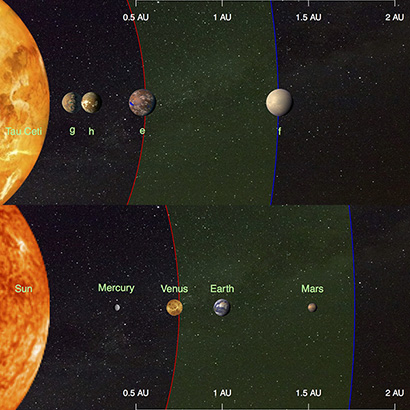 $1: This illustration compares the four planets detected around the nearby star tau Ceti (top) and the inner planets of our solar system (bottom). (Illustration courtesy of Fabo Feng) https://news.ucsc.edu/2017/08/tau-ceti-planets.html
|

 Posts:
Posts: 51900
 Posted: Posted: Mon Aug 21, 2017 6:32 am
NASA has changed the orbit of Cassini by using a gravity boost from Titan, and it is now on it's final orbits of Saturn. If you look east in the pre-dawn sky, you'll see Saturn. Launched in 1997, Cassini has about 3 weeks left before it burns up in Saturns' atmosphere. $1: End of Mission Timeline
In Cassini’s Grand Finale orbits — the final orbits of its nearly 20-year mission — the spacecraft travels in an elliptical path that sends it diving at tens of thousands of miles per hour through the 1,500-mile-wide (2,400-kilometer) space between the rings and the planet where no spacecraft has ventured before.
https://saturn.jpl.nasa.gov/mission/gra ... bit-guide/Where Cassini is in it's orbital track can be seen here, along with a 'live' shot from the craft. https://saturn.jpl.nasa.gov/mission/sat ... ssini-now/
|
 
|
Page 116 of 236
|
[ 3540 posts ] |
Who is online |
Users browsing this forum: No registered users and 3 guests |
|
|

